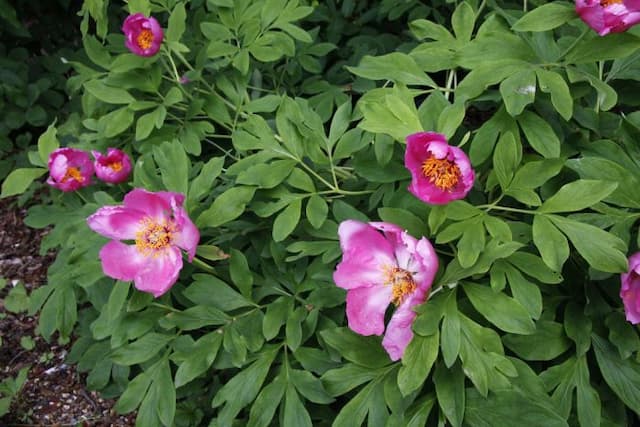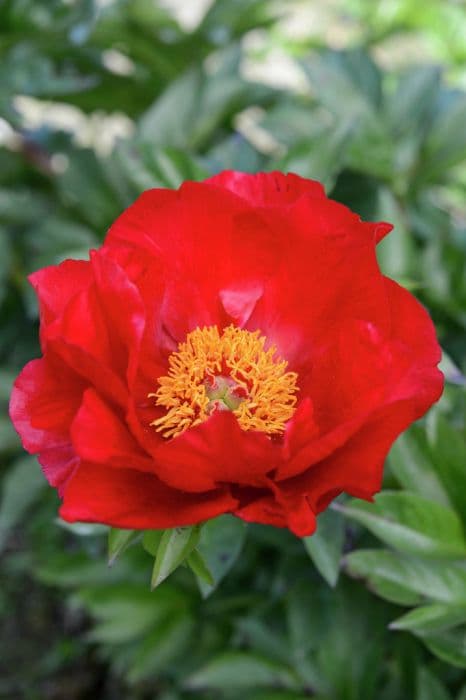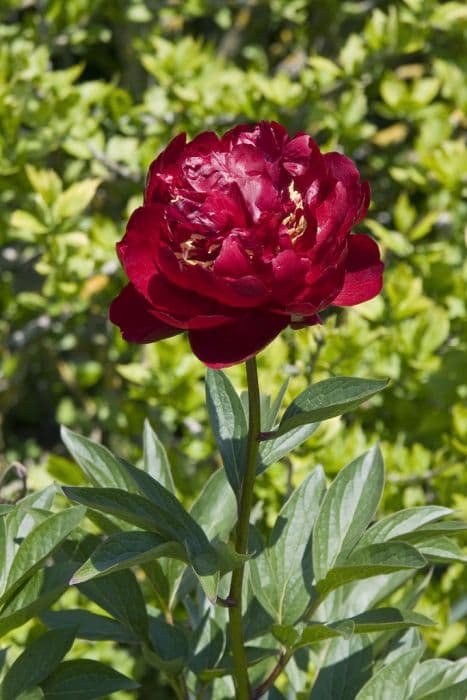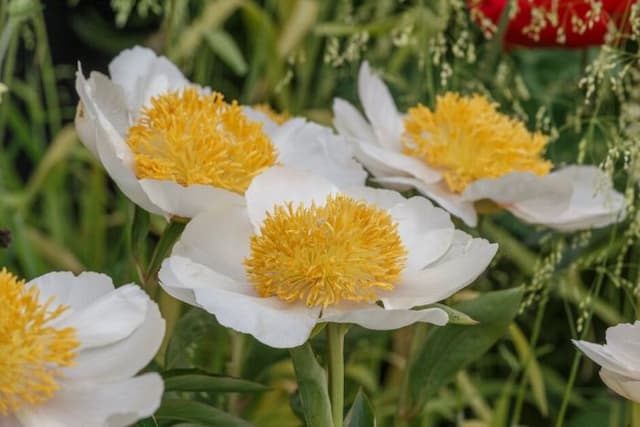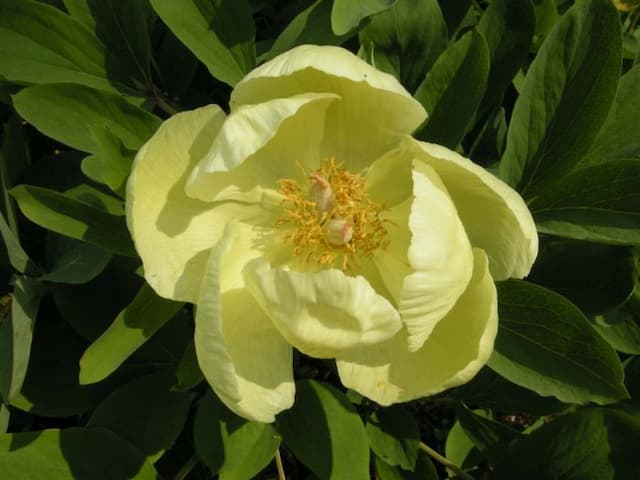Chinese Peony Paeonia lactiflora 'Bouquet Perfect'

ABOUT
The 'Bouquet Perfect' peony is characterized by its stunning blooms that make it a popular choice for gardens and floral arrangements. This plant produces large, full flowers that are renowned for their beauty and fragrance. The flowers have a rich, lush appearance, with layers of petals that can come in shades from soft creamy colors to more vibrant pinks. Each bloom has a set of outer guard petals that cradle the numerous, fluffy inner petals, creating a round, dense form. The foliage of the 'Bouquet Perfect' peony is deep green, providing a striking contrast with the softness of the flowers. The leaves are broad and glossy, with a typical peony shape that has a slight point at the tip. As a perennial plant, it emerges each spring with fresh, vigorous growth, setting the stage for the blossoming period. As a cultivar of the common garden peony, the 'Bouquet Perfect' has all the elegance and charm that peonies are loved for. It adds a romantic touch to any setting with its voluminous blooms and can serve as a focal point in garden landscapes or as a prized specimen in floral displays.
About this plant
 Names
NamesFamily
Paeoniaceae
Synonyms
Chinese Peony, White Peony
Common names
Paeonia lactiflora.
 Toxicity
ToxicityTo humans
The common name of Paeonia lactiflora 'Bouquet Perfect' is peony. Peonies are generally considered not poisonous to humans. However, sensitive individuals might experience mild stomach upset if any part of the plant is ingested in large amounts. It is important to remember that even non-toxic plants can pose a choking hazard, especially to children, and it is still best practice to avoid eating ornamental plants.
To pets
The common name of Paeonia lactiflora 'Bouquet Perfect' is peony. Peonies are considered to be mildly toxic to pets, including cats and dogs. If ingested by a pet, peonies can cause gastrointestinal upset, including symptoms such as vomiting and diarrhea. In most cases, the consumption of this plant by pets results in negligible toxicity, but it's always prudent to keep an eye on your pet and consult a veterinarian if any unusual behavior or symptoms arise after ingestion.
 Characteristics
CharacteristicsLife cycle
Perennials
Foliage type
Deciduous
Color of leaves
Green
Flower color
Pink
Height
2-3 feet (60-90 cm)
Spread
2-3 feet (60-90 cm)
Plant type
Herbaceous
Hardiness zones
3-8
Native area
Asia
Benefits
 General Benefits
General Benefits- Aesthetic Appeal: Paeonia lactiflora 'Bouquet Perfect', commonly known as the Chinese peony, adds striking beauty to gardens with its lush, full blossoms and vibrant colors.
- Landscape Versatility: Chinese peonies can be used in a variety of garden designs, including borders, foundation plantings, or as stand-alone specimens.
- Seasonal Interest: With a spring blooming season, Chinese peonies provide an eye-catching display that marks the transition from spring to summer.
- Perennial Growth: As perennials, Chinese peonies come back year after year, making them a long-term addition to gardens without the need for annual replanting.
- Cut Flower Use: The blooms of the Chinese peony are highly prized for cut flower arrangements thanks to their size, fragrance, and longevity in a vase.
- Wildlife Attraction: The flowers can attract pollinators like bees, contributing to the health of the garden ecosystem.
- Drought Tolerance: Once established, Chinese peonies have good drought tolerance, reducing the need for frequent watering.
- Cold Hardiness: Paeonia lactiflora 'Bouquet Perfect' is cold-hardy, making it suitable for cultivation in cooler climates.
 Medical Properties
Medical Properties- Anti-inflammatory: Peony may help reduce inflammation in the body.
- Analgesic: It has been used in traditional medicine to alleviate pain.
- Immunomodulatory: Peony is believed to modulate the immune system, potentially supporting immune health.
- Antispasmodic: The plant has been used to help relieve muscle spasms.
- Antioxidant: Peony contains compounds that may exert antioxidant effects, protecting against oxidative stress.
- Neuroprotective: There is some evidence to suggest it may have protective effects on the nervous system.
- Cardiovascular health: Peony might play a role in supporting heart health, although specific effects are not well characterized.
- Hepatoprotective: Some suggest that peony could help protect liver function.
- Antitumor effects: Constituents of peony have been investigated for their potential to inhibit tumor growth.
 Air-purifying Qualities
Air-purifying QualitiesThis plant is not specifically known for air purifying qualities.
 Other Uses
Other Uses- Perfumery: The petals of the peony can be used in the creation of fragrant oils and perfumes, contributing a distinct floral scent that is valued in the perfume industry.
- Culinary Garnishes: Peony petals, particularly from 'Bouquet Perfect', may be crystallized or used fresh to decorate desserts and other culinary creations for a touch of elegance.
- Fabric Dyeing: The petals can be used to produce natural dyes for fabrics, giving a soft pink to purple hue to textiles.
- Artistic Inspiration: Due to their large and colorful blooms, peonies often inspire artists and are used as subjects in painting, photography, and other visual arts.
- Cultural Symbolism: In many cultures, particularly in Asia, peonies are a symbol of prosperity, beauty, and honor, and are used in cultural ceremonies and artworks to convey these ideals.
- Wedding Décor: Peonies are popular in bridal bouquets and wedding decorations, symbolizing a happy marriage and often chosen for their lush and romantic appearance.
- Craft Projects: The flowers and leaves can be used in scrapbooking, card making, or other craft projects for their texture and color.
- Flower Arrangement Education: Peonies like 'Bouquet Perfect' are often used in floral design classes to teach students about the aesthetics and techniques of flower arranging.
- Horticultural Training: These peonies can serve as an educational tool in horticulture programs, where students can learn about plant growth, hybridization, and care.
- Children's Gardens: Because of their large, appealing flowers, peonies are often included in children’s gardens to stimulate interest in nature and gardening.
Interesting Facts
 Feng Shui
Feng ShuiThe Peony is often used in Feng Shui to promote romance and prosperity. It is commonly placed in the southwest corner of a garden or room to enhance love and marriage prospects. Its lush, full blooms are symbolic of abundance, and the plant is also associated with feminine beauty and the spring season.
 Zodiac Sign Compitability
Zodiac Sign CompitabilityThe Peony is not used in astrology practice.
 Plant Symbolism
Plant Symbolism- Prosperity: The Paeonia lactiflora, commonly known as the Chinese peony, is often associated with wealth and honor in Chinese culture, symbolizing affluence and abundance.
- Romance: With its full, lush blooms, the Chinese peony is seen as a symbol of romance and romantic love, reflecting beauty and the joys of partnership.
- Good fortune: The Chinese peony is believed to bring good luck, particularly in terms of marital bliss, making it a popular flower for weddings and celebrations.
- Compassion: Some traditions hold that the Chinese peony represents compassion, reflecting the gentle and nurturing nature of the plant.
- Femininity: Due to its large, soft petals, the Chinese peony has become a symbol for feminine beauty and grace, embodying the qualities often associated with womanhood.
 Water
WaterPeonies, including 'Bouquet Perfect', should be watered deeply once a week during their growing season if there hasn't been sufficient rainfall, providing about an inch of water each time. This equates to roughly 0.6 gallons per square yard. In drought conditions, increase watering to twice per week. Water at the base of the plant to avoid wetting the foliage, which can lead to fungal diseases. During the fall and winter, reduce watering as the plant goes dormant. It's vital to ensure that the soil drains well to prevent root rot.
 Light
LightPeonies, such as 'Bouquet Perfect', thrive in full sun to partial shade. They need at least six hours of sunlight per day to bloom well. Morning sun is especially beneficial because it helps dry dew from the leaves, thereby reducing the risk of fungal diseases. A spot that receives morning sunlight and afternoon shade is ideal, especially in warmer climates to prevent the blooms from fading too quickly.
 Temperature
TemperaturePeonies like 'Bouquet Perfect' are hardy in USDA zones 3-8, being able to withstand winter minimum temperatures down to -40°F and summer highs typically not exceeding 90°F. They perform best when the temperatures range between 65°F and 75°F. In the spring, peonies require a period of cool temperatures below 40°F to set their buds.
 Pruning
PruningPeonies like 'Bouquet Perfect' should be pruned to remove faded flowers after blooming, which helps to prevent seed formation and promotes better growth next season. In late fall, after the first frost, cut back the foliage to just above ground level to prepare the plant for winter and prevent overwintering diseases. Deadheading, or removing spent flowers during the blooming season, keeps peonies looking tidy and can sometimes encourage a second flush of smaller blooms.
 Cleaning
CleaningAs needed
 Soil
SoilThe best soil mix for the Peony 'Bouquet Perfect' is well-draining soil rich in organic matter with a pH of 6.5 to 7.0. A mixture of loamy soil, compost, and perlite or sand would be ideal to provide the necessary drainage and nutrients.
 Repotting
RepottingPeonies 'Bouquet Perfect' typically do not need to be repotted often. They are long-lived perennials that can thrive for years without repotting. Dividing or repotting can be done every 10 years or when the plant becomes too large.
 Humidity & Misting
Humidity & MistingPeony 'Bouquet Perfect' prefers average humidity conditions and does not require special humidity considerations. Maintaining natural outdoor humidity is generally sufficient for these plants.
 Suitable locations
Suitable locationsIndoor
Not ideal for indoor growth due to light and space needs.
Outdoor
Plant in sun, enrich soil, ensure drainage, space 3-4 feet apart.
Hardiness zone
3-8 USDA
 Life cycle
Life cyclePaeonia lactiflora 'Bouquet Perfect', commonly known as the Chinese peony, begins its life cycle when the seeds are sown in the soil, germinating to give rise to seedlings. After establishing a root system, these young plants grow into juveniles and then mature peonies, developing a robust clump of leaves each spring. The foliage serves as the energy harnessing mechanism through photosynthesis, enabling the plant to bloom in late spring to early summer with large, fragrant flowers that attract pollinators. Following pollination, the flowers produce seeds, completing the reproductive cycle. As temperatures cool in the fall, the Chinese peony enters dormancy, with the aerial parts dying back to the ground, conserving energy in the roots for the next growing season. This perennial cycle repeats annually, with the plant typically increasing in size and bloom capacity each year.
 Propogation
PropogationPropogation time
Early spring
Propogation: Paeonia lactiflora 'Bouquet Perfect', commonly known as the Chinese peony, is often propagated through division, which is the most popular method for this perennial plant. The best time to propagate by division is in the fall, after the plant has gone dormant post-flowering and the foliage has died back. This allows the plant to establish in the cooler condition without the stress of summer heat. To divide a Chinese peony, carefully dig up the entire plant, making sure to keep a generous amount of soil around the roots to minimize shock. The root ball should then be gently broken apart or cut with a sharp knife into sections, ensuring that each division has 3-5 eyes, which are the pink or white buds indicating future growth, and a good amount of root. The divisions should be planted at the same depth they were growing at previously, in a location with well-draining soil and full to partial sunlight. Water the new divisions thoroughly until they are well established.
